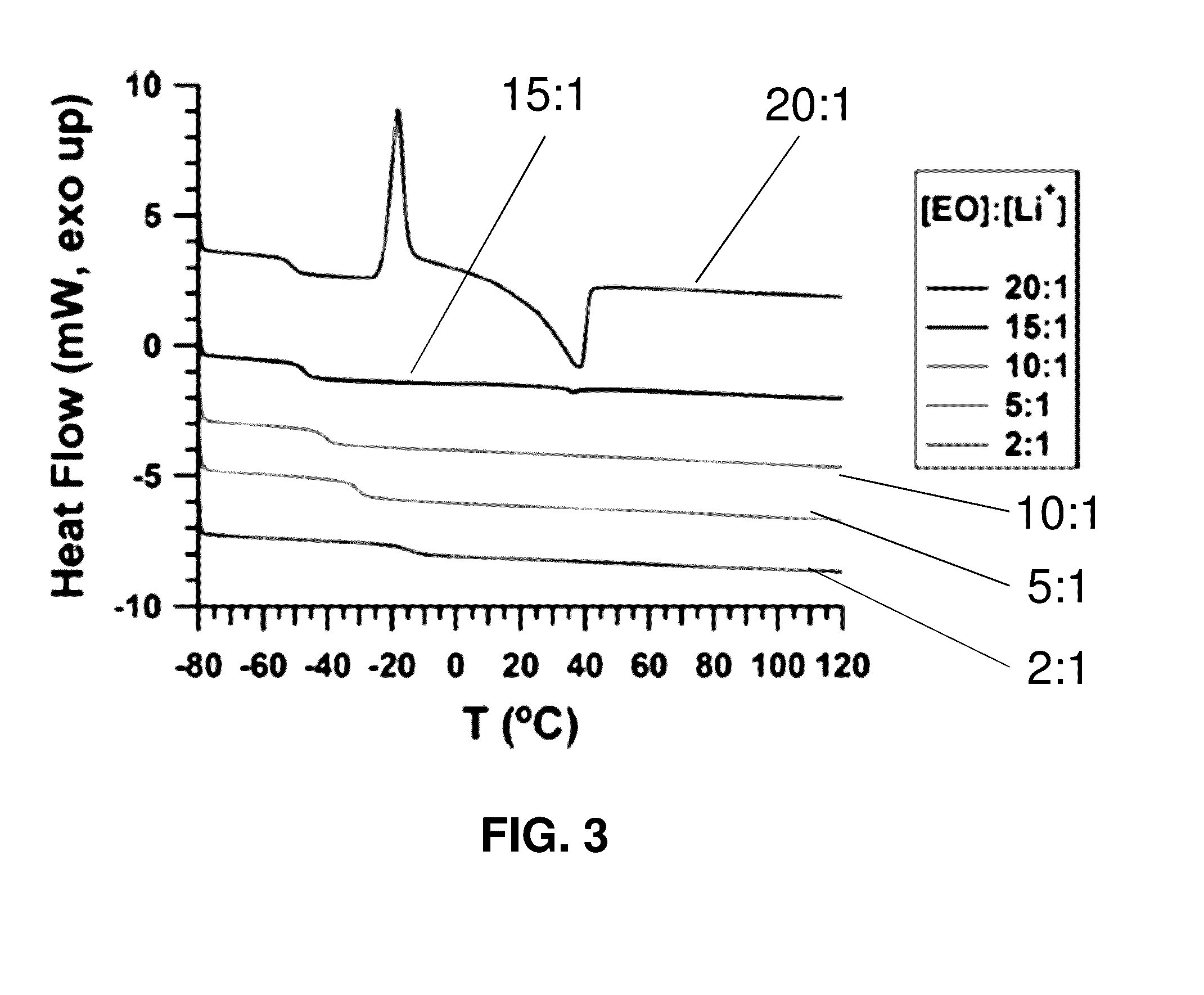Brush block copolymer electrolytes and electrocatalyst compositions
a technology of copolymer electrolytes and electrocatalysts, applied in the direction of electrochemical generators, fuel cells, non-aqueous electrolytes, etc., can solve the problems of less effective approaches and technical challenges in the development of block copolymers for solid electrolytes, and achieve the effect of reducing the modulus and speeding up the diffusion of small molecules
- Summary
- Abstract
- Description
- Claims
- Application Information
AI Technical Summary
Benefits of technology
Problems solved by technology
Method used
Image
Examples
example 1
Brush Block Copolymers for Polyelectrolyte Membranes
Overview
[0177]The present example provides description and experimental results supporting the following aspects of the present invention:[0178]Synthesis of fully grafted ABA brush triblock copolymers.[0179]Brush block copolymer (BBCP) electrolytes.[0180]BBCP / LiTFSI blends exhibiting high conductivity (equal to or greater than 10−3 S / cm at 105° C.), comparable to or better than previously reported systems of interest.[0181]Normalized conductivities that are significantly higher for BBCP / LiTFSI blends than for blends of Li salts with linear block copolymer analogues.[0182]Brush architectures conferring important advantages and opens opportunities for the design of polymer electrolyte membranes with high conductivity.[0183]BBCP ion gels.[0184]Polymer ion gels with embedded catalysts—a strategy that blends the benefits of solid state catalysis (shape persistence) with solution catalysis (liquid-like mobility, diffusion, and proven cat...
example 2
ABA Triblock Brush Polymers: Synthesis, Self-Assembly, Conductivity, and Rheological Properties
Abstract
[0256]The synthesis, self-assembly, conductivity, and rheological properties of ABA triblock brush polymers (BBCPs) with grafted polystyrene (A block, NPS=21) and poly(ethylene oxide) (B block, NPEO=45) side-chains is described. Two backbone molecular weights (NA:NB:NA=11:78:11 and 15:119:15) were investigated with lithium bis(trifluoromethylsulfonimide) (LiTFSI) doping ratios 2+]+]−3 S / cm at 105° C. with a corresponding elastic modulus circa 104 Pa. The optimum conductivity occurs at a blend ratio near 10:1 [EO]:[Li+], similar to that reported for linear block copolymer analogues.
Introduction
[0257]Lithium-ion batteries now pervade virtually all aspects of society, as evidenced by their extensive use in applications including personal computers, cell phones, automobiles, and spacecraft. These batteries display good performance across a range of temperatures (commonly 0-40° C.) in p...
example 3
Brush Block Copolymers
Background:
[0336]Batteries require electrolytes that physically separate the anode and cathode and simultaneously enable the reversible movement of charge. Lithium ion batteries typically utilize highly conductive liquid electrolytes that suffer from safety issues associated with lithium dendrite growth and the use of flammable small molecule solvents. Significant research efforts have thus been directed towards identifying polymeric materials (“polymer electrolyte membranes”) to replace liquid electrolytes. Most materials comprise poly(ethylene oxide) (PEO) or copolymers thereof that conduct lithium ions when doped with lithium salts.
Summary:
[0337]Described are brush block copolymer (BBCP) materials that exhibit improved lithium ion conductivity compared to linear analogues. The BBCPs contain poly(norbornene) polymer backbones with side chain brushes composed of polystyrene (PS) and poly(ethylene oxide). Two architectures have been synthesized, including AB di...
PUM
| Property | Measurement | Unit |
|---|---|---|
| loss modulus | aaaaa | aaaaa |
| loss modulus | aaaaa | aaaaa |
| molecular weight | aaaaa | aaaaa |
Abstract
Description
Claims
Application Information
 Login to View More
Login to View More - R&D
- Intellectual Property
- Life Sciences
- Materials
- Tech Scout
- Unparalleled Data Quality
- Higher Quality Content
- 60% Fewer Hallucinations
Browse by: Latest US Patents, China's latest patents, Technical Efficacy Thesaurus, Application Domain, Technology Topic, Popular Technical Reports.
© 2025 PatSnap. All rights reserved.Legal|Privacy policy|Modern Slavery Act Transparency Statement|Sitemap|About US| Contact US: help@patsnap.com



